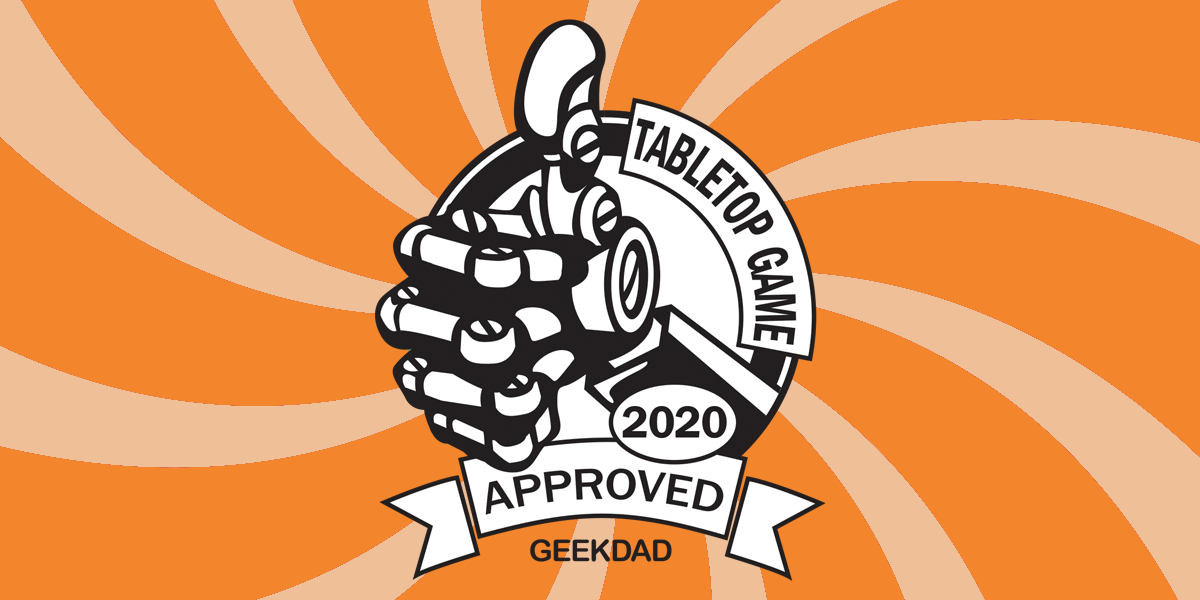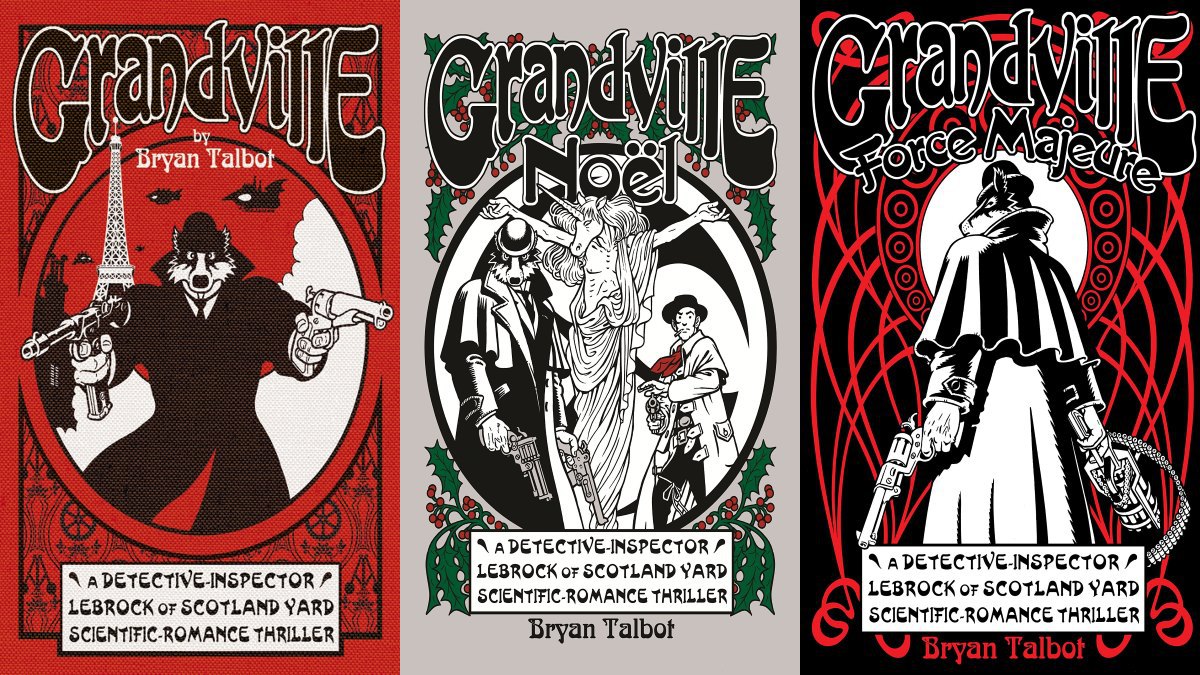 Bigfoot versus Robin Hood? Bruce Lee versus Medusa? Set your fight card and see who will come out on top in the Unmatched game series.
Bigfoot versus Robin Hood? Bruce Lee versus Medusa? Set your fight card and see who will come out on top in the Unmatched game series.
Unmatched is GeekDad Approved!
What Is Unmatched?
The Unmatched games are 2-player miniature skirmish games for ages 9 and up, that take 20-40 minutes to play, and can alternately be played in a 4-player team mode. The games are “restored” from the system created for Star Wars: Epic Duels, originally published by Milton Bradley. They are standalone games from which you can mix and match the maps and heroes, and range in price from $15-$40. The Unmatched games are available for purchase in stores or online, including directly from co-publishers Mondo Games and Restoration Games.

Mondo sent me the two most recent standalone expansions to Unmatched: Jurassic Park- InGen vs Raptors ($30) and Cobble & Fog ($40). The basic rules for all Unmatched games are the same, so you’ll be getting two reviews today for the price of one!

Unmatched: Jurassic Park- InGen vs Raptors Components
- 4 Hero miniatures
- 60 Action cards
- 4 Health dials
- 2 Character cards
- 3 Sidekick tokens
- 10 trap tokens
- 1 Gameboard

Unmatched: Cobble & Fog Components
- 4 Hero miniatures
- 120 Action cards
- 5 Health dials
- 4 Character cards
- 4 Sidekick tokens
- 3 Fog tokens
- 1 Transformation token
- 1 Double-sided Gameboard with 2 battlefields
The components for both Unmatched games are uniformly excellent. One of the first things you’ll notice upon opening up either box are the hero miniatures. Not only are they well-sculpted and evocative of the source material, but they have an application of shade paint applied, to help bring out the details of the figures. Here’s a gallery showing off the miniatures from the two boxes:
The graphic design in both games is fantastic. The cards have gorgeous artwork on the fronts and the backs, and the layout is uncluttered and very clear and easy to read. Tokens are well made, and come in both screen-printed plastic discs for the “sidekicks” and heavy cardboard for others such as Hyde’s transformation token:
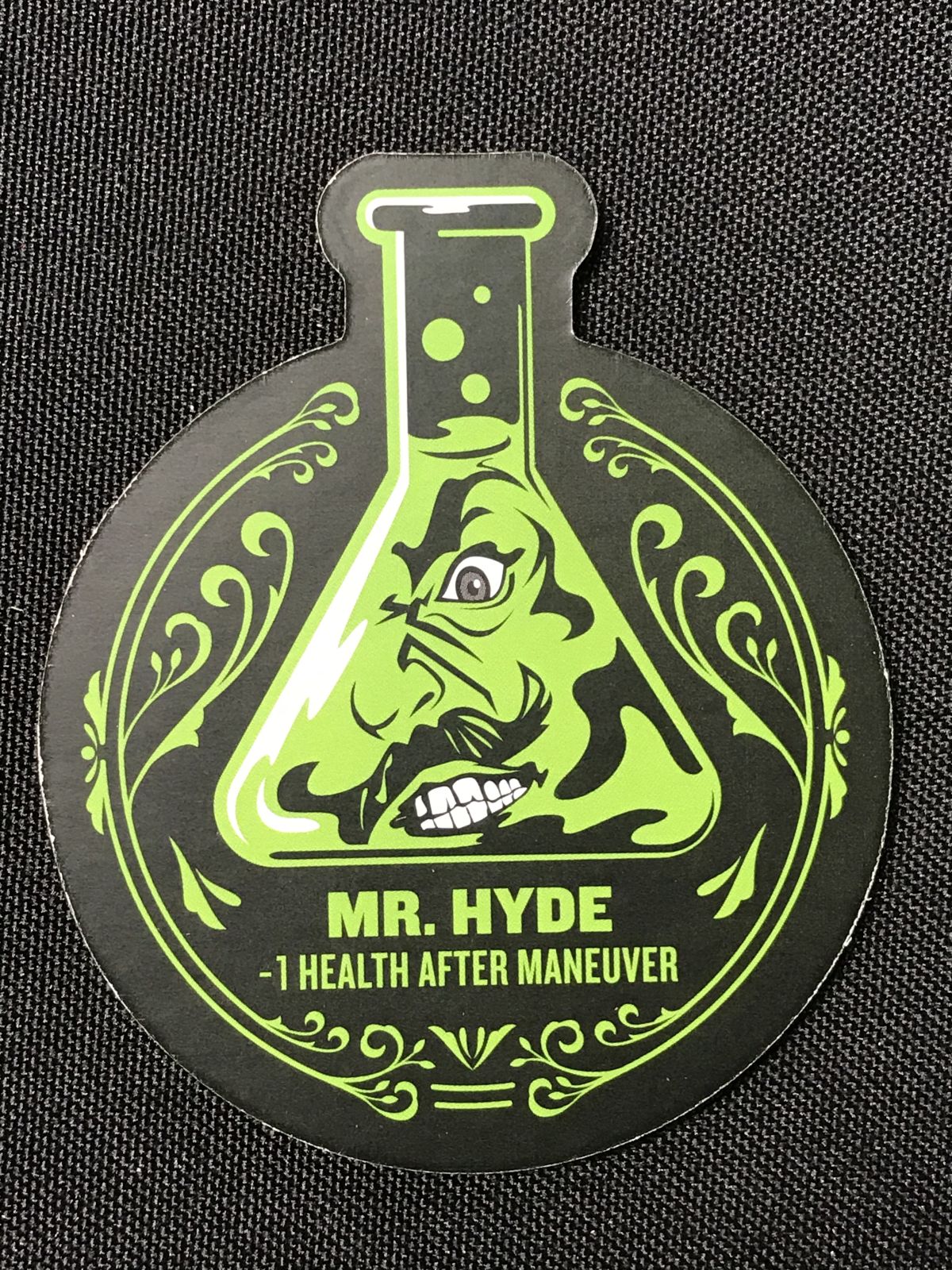
Special mention should be made of the inserts that come in the game boxes. While there aren’t as many components in these boxes as you’ll find in many other games, there’s still a sensible place to put each and every game piece in the insert, and everything is sorted by individual character. This obviously allows for a very quick setup when looking to pit one hero against another.
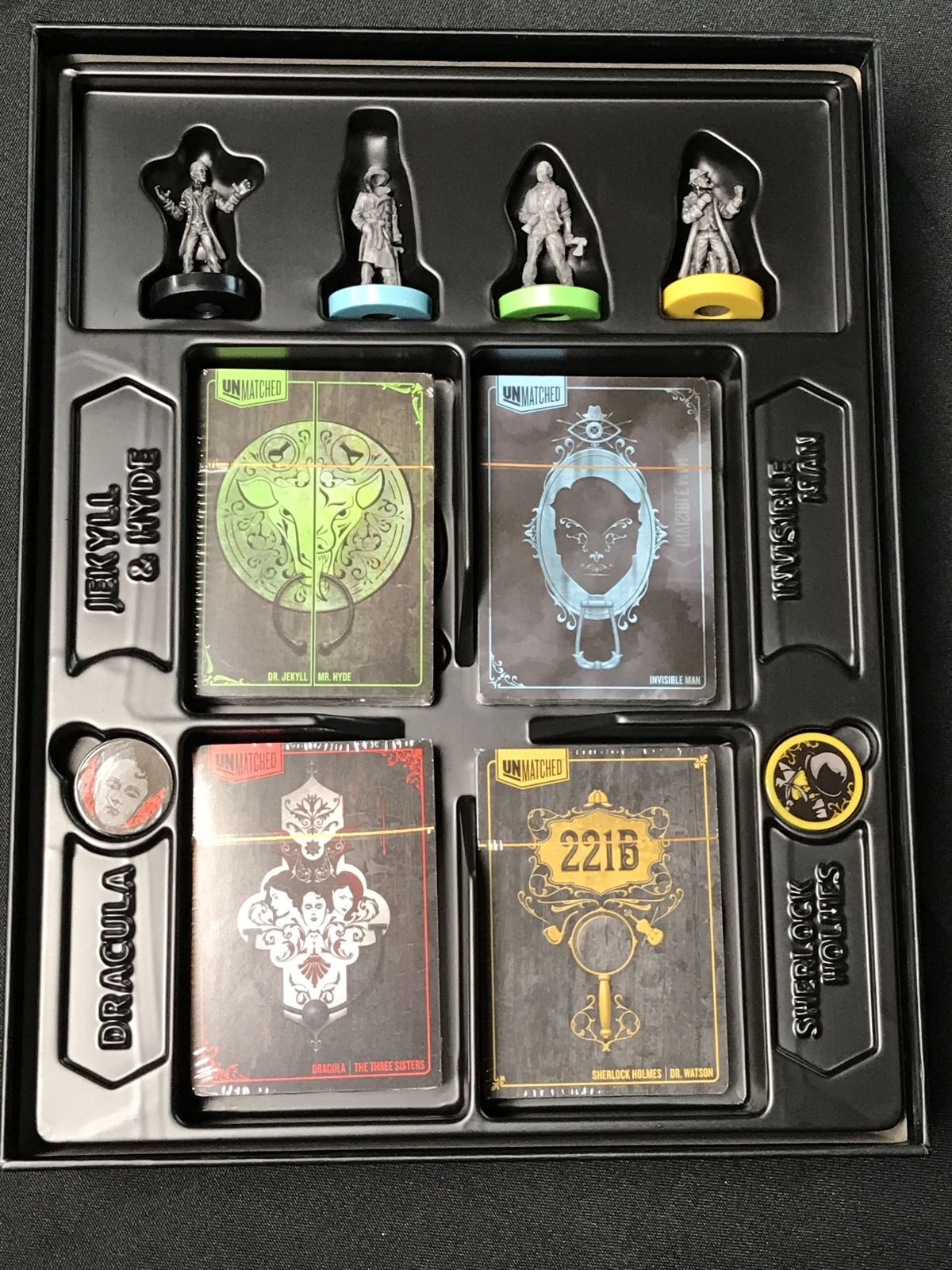
Here’s a look at the Jurassic Park insert, showing how the matching health dials rest in a recessed space below the card decks. Not pictured is the stack of trap tokens, which have their own space right below Muldoon’s health dial.

You may also see a ridge running around the inside rim of the inserts…that is where the game board and instruction booklet will sit. All in all, the inserts are a phenomenal storage solution, and one I wish more board games would have.
How to Play Unmatched
You can download a copy of Jurassic Park- InGen vs Raptors rules here or the rulebook for Cobble & Fog here. All games of Unmatched share the same setup and basic rules, but some characters and battlefields will have their own unique individual rules.
The Goal
To defeat your opponent’s hero by reducing their health to zero.
Setup

Choose a battlefield and lay it out on the table. Each player then chooses a hero and takes their corresponding card deck, miniature, sidekick tokens (if any), health dials, and any hero-specific tokens.
Set hero and sidekick health dials to the starting level as indicated on their cards. Note: Sidekicks without health dials have 1 health.
Shuffle the respective hero decks. Each player then draws a starting hand of 5 cards.
The youngest player places their hero in the “1” space on the battlefield. If that hero has any sidekicks, those are placed in the same zone as the hero. (Zones are comprised of all spaces that share a matching color.) The other player places their hero on the “2” space and similarly places any sidekicks they may have. The youngest player then takes the first turn.
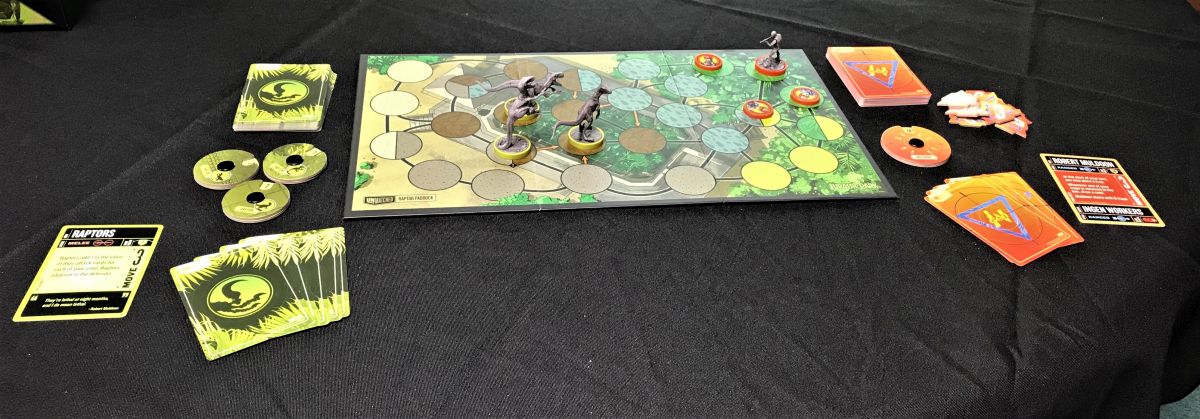
Gameplay
On your turn, you must take 2 actions, chosen out of the three different actions. Alternatively, you may take any one of the three actions twice. These are the actions:
Maneuver
First, you must draw the top card of your deck and add it to your hand. Then, you may optionally move any or all of your fighters a number of spaces up to their maximum speed as noted on the hero card, one at a time.
You also have the option to boost movement by discarding a single card from your hand and adding the boost value printed on that card to your movement value for that turn.
Scheme
Choose a scheme card from your hand and place it face up, resolving the effect. Note: Some cards may only be played by certain fighters, which will be noted on those cards.

Attack
Combat is done in three steps.
1. Declare Target
Declare which of your fighters is making the attack, and which opposing fighter is the target of the attack. Fighters that are melee may only attack fighters in adjacent spaces, whereas ranged fighters may attack either an adjacent target or any fighter that shares the same zone as the attacker.

2. Choose and Reveal
The attacking player chooses an attack card and places it face down. The defender then has the option of playing a defense card, which they also place face down. Both cards are then revealed at the same time.
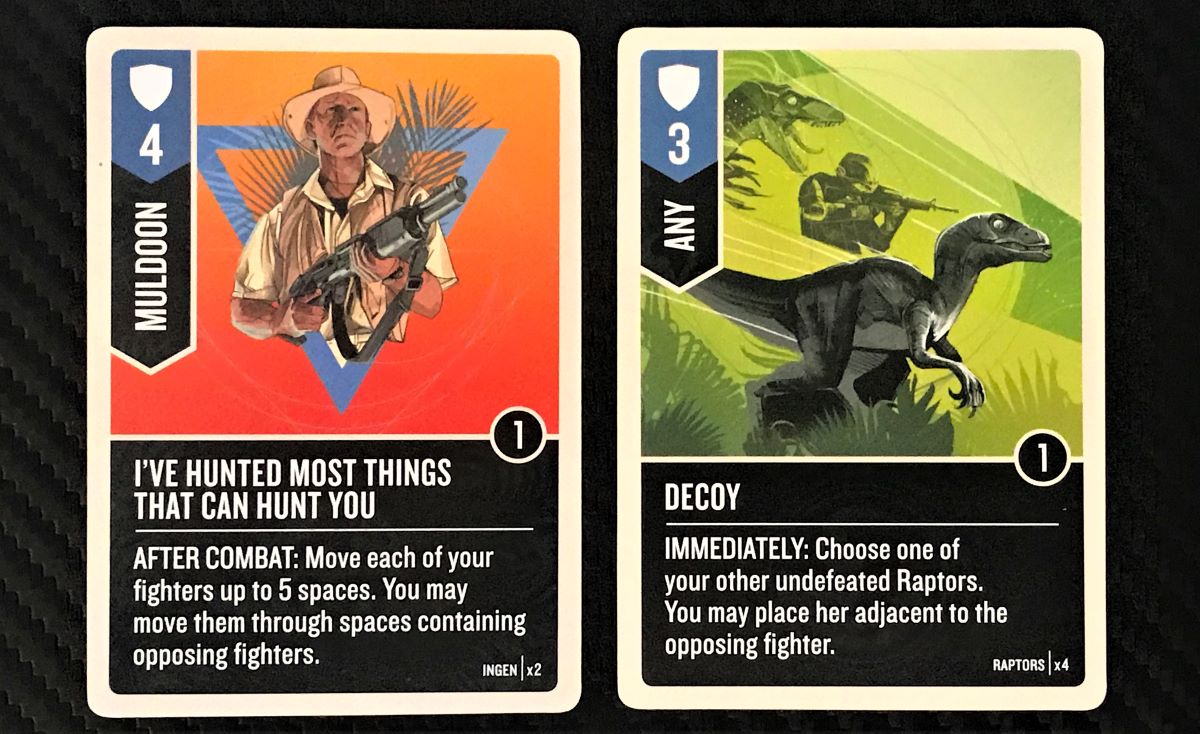
3. Resolve Combat
All attack and defense cards have both an attack or defense value, and an effect that will resolve at some point during the combat.
First, resolve any effects that occur Immediately. Note: If both the attacker and defender have cards that would resolve at the same time, the defender resolves theirs first.
Then resolve any effects that occur During Combat.
Next, determine the combat results by comparing the value of the attack card with the value of the defense card. If the attack value is greater, deduct the difference in points from the defender’s health dial.
Next, resolve any After Combat effects. And finally, place all played cards in their respective discard piles.

Note: Some cards are also “versatile,” and can be played either for attacking or defending.
Team Play
You can play 4-player games with two teams of two but must use one of the larger battlefields (such as the ones in the Cobble & Fog set) that have four starting spaces. Setup and play alternate between each player on each team, and you must defeat all the heroes on the opposing team to win.
Game End
If a fighter’s health is reduced to zero, they are defeated and removed from the board. If your hero is defeated, then you lose the game.
Unmatched: The Verdict
As kids (or as geeky adults), we’d often ask those all-important questions: “Who would win in a fight, Superman or Thor? Robocop or the Terminator?” The Unmatched series takes this conceit and runs with it. You can plunk such disparate figures as Bigfoot and Alice in Wonderland (with an assist from the Jabberwocky) down onto your tabletop, and fight to the death.
One of the most impressive things that the designers have done is to take all these seemingly unmatchable characters from literature and popular culture and give them unique playstyles that are not only thematic but reasonably balanced against each other.

In Jurassic Park- InGen vs Raptors, the three raptors work together, with many of their cards emphasizing the pack hunting nature of the dinosaurs that we’re familiar with from the film. Muldoon is no slouch himself however; not only does he have three InGen sacrificial lambs, er, sidekicks to help fight the raptors, but he has a special ability to lay traps. These traps by themselves only do a single point of damage, but they also work in concert with other cards for various effects.
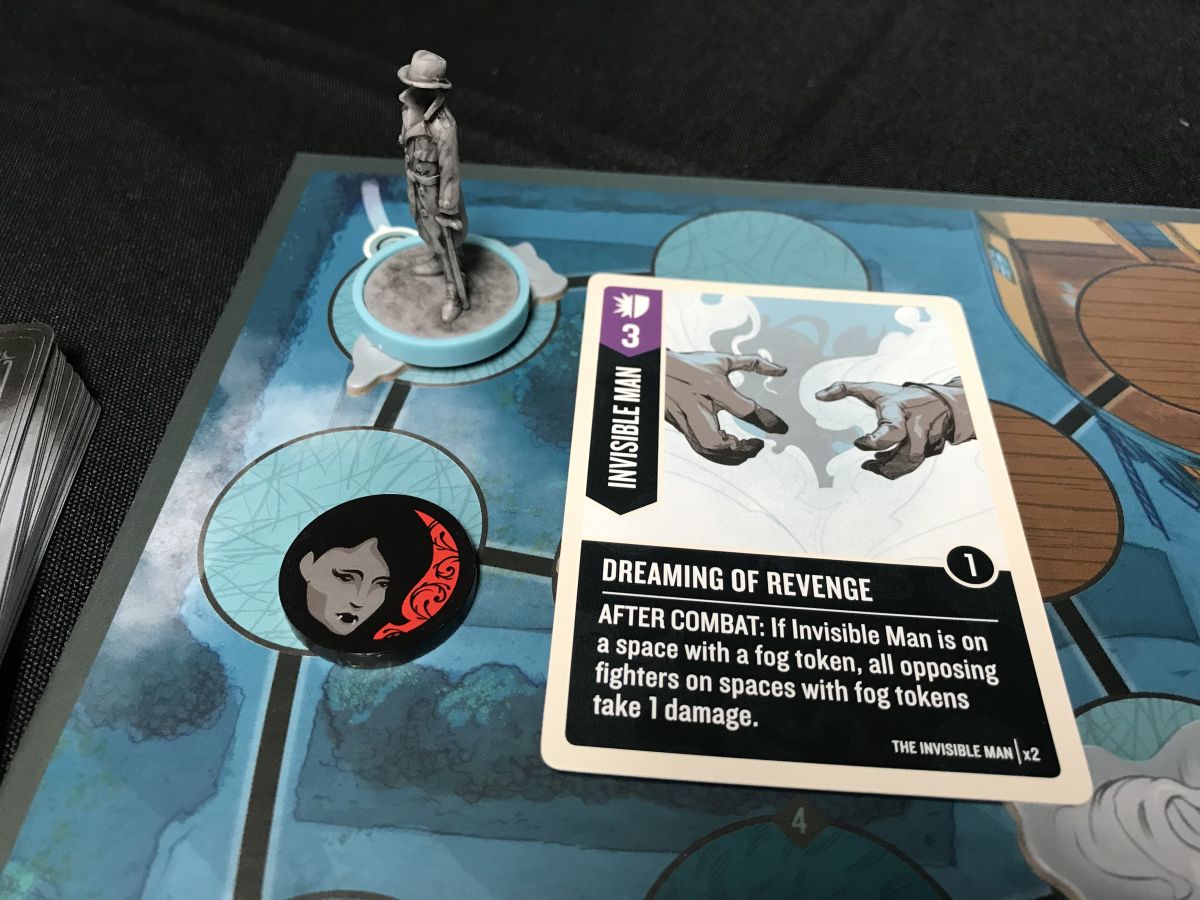
Cobble & Fog is a larger set, and each of the characters in that box also has their own unique flavors. Dr. Jekyll can transform into Mr. Hyde. When he does so he takes a point of damage when he maneuvers, but becomes much more powerful in his attacks. And there are many cards in his deck that will only work for either Jekyll or Hyde, so you’ll have to decide when it’s advantageous to shift between the two personas.
The Invisible Man has three fog tokens that both the controlling player and their opponent can move around the board during the game. The Invisible Man can move between the fog tokens as if they were adjacent, and has many card effects that will allow him to “disappear” into the fog, which also increases his defense when he is attacked.
Dracula has his three brides to help him attack, who can lure opponents in or help move Dracula next to his victims. And Dracula is no slouch either; he can deal a point of damage automatically to an enemy adjacent to him at the start of his turn, and even recover health and bring his defeated brides back to undead life.
Sherlock Holmes and his trusty companion Doctor Watson bring a mix of melee (Holmes) with ranged attacks (Watson). Holmes’ powers of deduction translate into several card effects that manipulate his opponent’s hand of cards, while Watson can aid Holmes and provide some much needed first aid, as well as dish out some considerable damage with his revolver.
Battlefields can also affect gameplay. With the Jurassic Park battlefield, some pathways are one-way. And with the “Baskerville Manor” side of the Cobble & Fog 2-sided battlefield, you get secret passages that allow you to enter one of the four passages and pop out at any of the other three.

Besides playing games with the two sets by themselves, I, of course, needed to see what would happen when I mixed both sets together. And so, I decided to find out what would happen when you took the most cunning predators of the Cretaceous period and set them against the greatest detective of all time on the streets of Soho. And so, it was Sherlock Holmes vs the raptors.
Unfortunately for Dr. Watson, he was targeted early on by the raptors and was shortly surrounded and met his end. But this gave Holmes time to maneuver, getting a hand of cards that would serve him well. Holmes went on the offensive. Soon, it was down to just one raptor and Sherlock Holmes. And thanks to some card manipulation, the raptor was left defenseless. Holmes delivered the killing blow, thus winning the game.

And that’s a big part of the joy of the Unmatched games. Not only can you have plenty of fun within each individual game box, but you can mix and match the heroes and battlefields of all the sets, creating endless possibilities. There are currently three other Unmatched sets available besides the two I covered here: Unmatched: Battle of Legends, Volume One, Unmatched: Robin Hood vs Bigfoot, and Unmatched: Bruce Lee. The back of the Unmatched: Jurassic Park rulebook teases additional Jurassic Park sets, including one with a T-Rex. And from the illustration, it looks to be in scale to the other miniatures, too!
I had a blast in all my games of Unmatched. The production quality is top-notch, and the skirmishes play nice and quick so you can easily get several games in a row in. And for those occasional times where you might run into someone who’s turtling and dragging out the game, there’s even a built-in game timer mechanism to handle that. If you ever run through your deck of 30 hero cards, you don’t get to reshuffle your discard pile. Instead, each time you need to draw a card, your fighters will each take 2 damage.
If you’re looking for a fun, easy to teach and learn game that’s still immensely satisfying to strategize with, I highly recommend the Unmatched series. I very much enjoyed both Jurassic Park- InGen vs Raptors and Cobble & Fog, and can’t wait to try out some of the other sets. And I admit that I’m just a tiny bit afraid of the day when my opponent places that enormous T-Rex onto the battlefield opposite my hero.
Be sure to visit the Mondo shop or Restoration Games to pick up your own copies of the Unmatched series of games. They can also be purchased from Amazon.
![]() To subscribe to GeekDad’s tabletop gaming coverage, please copy this link and add it to your RSS reader.
To subscribe to GeekDad’s tabletop gaming coverage, please copy this link and add it to your RSS reader.
Click here to see all our tabletop game reviews.
Disclosure: GeekDad received a copy of this game for review purposes.
